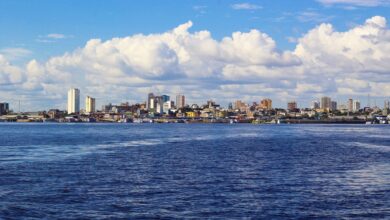Floating Cities: The Future Due to Climate Change?
Faced with the environmental crisis, floating cities emerge as a housing alternative in the midst of an increasingly warm planet.

Oceanix City, a citadel built by the company of the same name, is developing a housing project, which they themselves have called resilient and sustainable, for 10,000 people. Photo: TW-OceanixCity
LatinAmerican Post | María Fernanda Ramirez Ramos
Listen to this article
Leer en español: Ciudades flotantes: ¿el futuro debido el cambio climático?
The United Nations has warned that without urgent action, by 2050 there will be more plastic than fish in the ocean. Furthermore, since 1980, the sea level has risen by around 24 centimeters. Faced with this worrying panorama, floating cities emerge as a housing alternative in the midst of the environmental crisis. In this article, we will tell you more about this life model.
The National Office of Oceanic and Atmospheric Administration (NOAA) has indicated that by 2100 the sea level could rise about 30 centimeters. However, this is an optimistic scenario, since in the worst case, the projections indicate that it could be 2.5 meters. This poses a risk to islands and coastal cities, which are increasingly exposed to natural disasters. This is why the UN and other organizations have seen in the construction of floating cities an alternative to adapt to the crisis that is unleashing global warming.
We recommend you read: Plants to capture carbon: an opportunity to combat climate change
Oceanix City, a citadel built by the company of the same name, is developing a housing project, which they have called resilient and sustainable, for 10,000 people. The first stage of city will be built with a platform model, inhabited by about 300 people who will form a community. It is a construction that adapts to climate change and that promises to be resistant to eventual changes that occur in humanity
This type of construction on the oceans is designed to be coupled with the rise in sea level and the sustainability challenges that climate change is imposing. In this way, from the beginning, they are planned to guarantee organized growth, the use of renewable energies and the development of a cyclical agronomy that adapts to annual changes. In addition, they are prepared to assume a model of low energy consumption and low cost in implementation.
Are floating cities our future? https://t.co/ff9bag2UCE via @bbc_travel
— OCEANIX (@OceanixCity) October 4, 2021
For these reasons, they could be the ideal city model to allow migrants to adapt and develop their homes legally, and with quality of life. Contrary to what is happening in many Latin American and European countries with migratory crises and illegal settlements.
However, the real challenge for the countries of the global south, which will be among the most affected by the rise in sea level, is that, if the floating cities model is implemented, they will be planned with the same level of organization and sustainability, than the first floating cities that are being developed in the world, such as Oceanix.
On the other hand, in fact, some governments have already taken their first steps in advancing the construction of this type of structure. For example, the Government of the Maldives, located in the Indian Ocean, has announced that in 2022 the construction of a floating city will begin to face the danger they suffer from the imminent rise in sea level.
Also, companies that are developing trials with these types of cities have guaranteed that these are long-term investments. In the Maldives, as we have indicated, a project is being developed with an area of 200 hectares, in which there will be houses and entertainment areas. Furthermore, it is intended to be capable of dealing with environmental damage without causing great harm to human beings.
In addition to the aforementioned islands, there are a kind of floating plants that will be able to capture CO2 from the environment and convert it into methanol. These are islands that run on wind energy with zero carbon emissions. However, due to environmental conditions, the best places to locate them would be Australia or Latin America, which represents a significant initial expense, although in the future they are sustainable.




